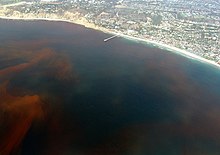Gonyaulax

| Systematik |
|---|
Gonyaulax is a genus of dinoflagellates with the type species Gonyaulax spinifera (Claparède et Lachmann) Diesing. Gonyaulax belongs to red dinoflagellates and commonly causes red tides.[1]
Structure
Gonyaulax is a genus of dinoflagellates that are aquatic organisms that with two separate flagella, each having characteristics of both a plant and animal organism. These algae have two separate flagella: one flagella extends backward, and the other wraps around the cell in a lateral groove helping to keep the organism afloat by creating rotational swimming.[2] The plate formula in the genus Gonyaulax Diesing was redefined as Po, 3', 2a, 6", 6c, 4-8s, 5'", 1p, 1"".[3]
Classification
All species are marine, except for one freshwater species Gonyaulax apiculata.[3]
It previously included several species, which are now considered to belong to a separate genus, e.g.:[3]
- Gonyaulax tamarensis (now: Alexandrium tamarense)
- Gonyaulax grindleyi (now: Protoceratium reticulatum)
- Gonyaulax polyedra (now: Lingulodinium polyedrum)
Adaptations
Gonyaulax dinoflagellates has evolved a type of resting spore, a resting cyst, to enable it to survive harsh weather conditions. Resting cysts can be formed when temperature or salinity changes in the surrounding water. These cysts are round mucous covered bodies that gain a reddish color. This color helps to form the Red Tide as further described. Gonyaulax catenella has been recorded forming vegetative cysts in response to cold water.[4]
Reproduction
Gonyaulax species will reproduce in long chains of protists, especially when faced with turbulent water conditions. These chains allow for clustering of organisms for increased mating, and protection of weak swimming organisms that could otherwise be washed away.[4]
Effect on Humans
Although Gonyaulax is predominantly found in seawater, it can also have a detrimental effect on humans. Filter feeding organisms e.g. mussels, clams etc. can accumulate these dinoflagellates in their bodies. When humans eat these shellfish after dinoflagellate accumulation during Red Tide season, usually during the warmer months of the year, it can poison the person who eats it.[2]
Red Tide
Red tide is a discoloration of the sea water that the Gonyaulax species inhabit. These are typically caused by the dinoflagellate species. Red tide is a toxic event that can kill any type of underwater creature that comes in contact with it. The Red Tide effect that is caused by the reproduction of many dinoflagellates contains some of the most toxic poisons known to date. For example, Gonyaulax spinifera has been related to production of yessotoxins (YTXs), a group of structurally related polyether toxins, which can accumulate in shellfish and can produce symptoms similar to those produced by paralytic shellfish poisoning (PSP) toxins.[5] Red Tide and PSP are both caused by ingestion of dinoflagellates and their toxins.
References
Further reading
- A W White: MARINE ZOO PLANKTON CAN ACCUMULATE AND RETAIN DINOFLAGELLATE TOXINS AND CAUSE FISH KILLS. In: ASOL Limnology and Oceanography. 26. Jahrgang, Nr. 1, Januar 1981, S. 103–109, JSTOR:2835810.
- Patricio Diaz, Carlos Molinet, Miriam Seguel, Gissela Labra, Rosa Figueroa: Coupling planktonic and benthic shifts during a bloom of Alexandrium catenella in southern Chile: Implications for bloom dynamics and recurrence. In: Harmful Algae. 40. Jahrgang, Nr. 1, Dezember 2014, S. 9–22, doi:10.1016/j.hal.2014.10.001.
- ↑ Franco Rollo, Stefano Sassarolil, Laurita Boni, Isolina Marota: Molecular typing of the red-tide dinoflagellate Gonyaulax polyedra in phytoplankton suspensions, in: AQUATIC MICROBIAL ECOLOGY (Aquat microb Eco 9). Band 9. Camerino, Italy 28. April 1995, S. 55 (int-res.com [PDF; abgerufen am 25. April 2015]).; doi:10.3354/ame009055
- ↑ a b Gonyaulax | dinoflagellate genus In: Encyclopedia Britannica. Abgerufen am 13. April 2017 (englisch).
- ↑ a b c Dodge J.D. 1989. Some revisions of the family Gonyaulacaceae (Dinophyceae) based on scanning electron microscope study. Bot. Mar. 32: 275-298.; doi:10.1515/botm.1989.32.4.275
- ↑ a b Gonyaulax Adaptations. In: bioweb.uwlax.edu. Abgerufen am 13. April 2017 (amerikanisches Englisch).
- ↑ Barbara Kirkpatrick, Lora E. Fleming, Dominick Squicciarini, Lorrie C. Backer, Richard Clark, William Abraham, Janet Benson, Yung Sung Cheng, David Johnson: Literature review of Florida red tide: implications for human health effects. In: Harmful Algae. 3. Jahrgang, Nr. 2, 1. April 2004, S. 99–115, doi:10.1016/j.hal.2003.08.005, PMID 20411030, PMC 2856946 (freier Volltext) – (sciencedirect.com).




